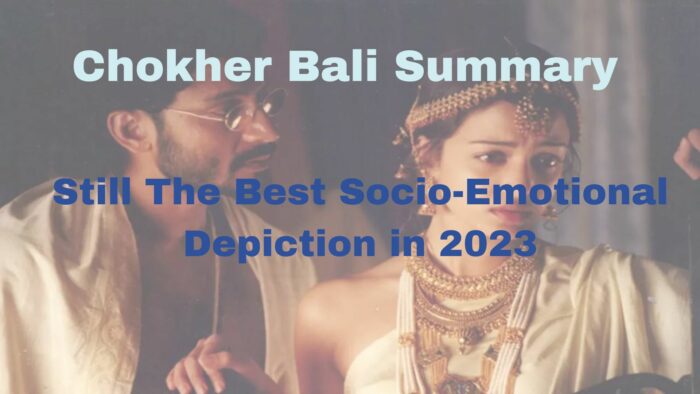
Chokher Bali Summary: Still The Best Socio-Emotional Depiction in 2023
Chokher Bali Summary is elaborately discussed in this article reflecting almost all the aspects Chokher Bali is a captivating novel written by Rabindranath Tagore, one of the most celebrated authors in Indian literature. Set in the early 20th century, this story explores the lives of four individuals – Binodini, Mahendra, Ashalata, and Behari – as they navigate love, desire, and societal expectations in colonial Bengal.
With its intricate plot and rich character development, Chokher Bali is a compelling tale that delves into the complexities of human relationships and the consequences of our choices. At the heart of this story is Binodini, a young widow who becomes the catalyst for a series of events that will change the lives of those around her.
As the forbidden desires and secrets of the characters unravel, the readers are drawn into an emotional rollercoaster that explores themes of love, betrayal, and self-discovery. With its vivid descriptions and insightful narratives, Chokher Bali enthralls readers with its exploration of moral dilemmas and the consequences of our actions.
Overall, Chokher Bali is a thought-provoking novel that captivates readers with its engaging plot and well-drawn characters. Tagore’s masterful storytelling and profound understanding of human nature make this book a must-read for anyone seeking a compelling tale of love, desire, and the complexities of life.
Chokher Bali Summary: The Main Theme
Chokher Bali Summary: Elaborate Discussion
Chokher Bali, a novel written by Rabindranath Tagore, tells the story of Binodini, a young widow who comes to live in the household of Mahendra and his mother Rajlakshmi. Set in late 19th-century Bengal, the novel explores themes of love, desire, and the consequences of societal norms.
The story begins with Binodini arriving at Mahendra’s house, where she quickly forms a close bond with Rajlakshmi. Binodini’s beauty and intelligence captivate Mahendra, leading to a complex love triangle between Binodini, Mahendra, and his wife, Ashalata. As the story unfolds, the characters grapple with their desires, loyalty, and the constraints imposed by society.
What Are The Main Characters In Chokher Bali?
The main characters in Chokher Bali include Binodini, Mahendra, Ashalata, and Rajlakshmi. Binodini is a young widow who represents beauty, intelligence, and independence. Mahendra is a charming and impulsive young man who becomes infatuated with Binodini. Ashalata is Mahendra’s wife,
who struggles with her own insecurities and desires. Rajlakshmi is Mahendra’s mother, who forms a close bond with Binodini and plays a significant role in shaping the events of the story.
Other supporting characters include Behari, a family friend who is secretly in love with Binodini, and Bihari, Mahendra’s loyal servant. Each character contributes to the intricate web of relationships and emotions that drive the narrative forward.
What Is The Setting Of Chokher Bali?
To know the Chokher Bali summary, we need to know about the time period of the novel in course to understand the depictions clearly. Chokher Bali is set in late 19th-century Bengal, during the time of British colonial rule. The story primarily takes place in Kolkata, then known as Calcutta,
which serves as the backdrop for the complex relationships and societal dynamics explored in the novel. The city’s bustling streets, opulent mansions, and traditional customs provide a rich and vibrant setting for the unfolding drama.
Additionally, the novel also briefly explores the rural countryside of Bengal, highlighting the contrast between urban and rural life. This setting allows Tagore to delve into the various social and cultural nuances of the time, shedding light on the complexities of Bengali society during this period.
What Are The Major Themes In Chokher Bali?
Chokher Bali delves into several major themes, including love, desire, societal norms, and the consequences of one’s actions. The novel explores the complexity of human relationships, particularly the destructive power of unfulfilled desires and the consequences of betraying societal norms.
Another significant theme is the portrayal of women and their struggle for agency and independence within a patriarchal society. Tagore critiques the restrictive societal norms that confine women and explores their desires, ambitions, and the consequences of their choices.
What Is The Significance Of The Title Chokher Bali?
The title “Chokher Bali” translates to “A Grain of Sand in the Eye” in English. It symbolically represents the intrusion of desire and temptation into a seemingly harmonious household. The grain of sand in the eye causes discomfort and irritates the eye, just as desire and forbidden love disrupt the peace and equilibrium of the characters’ lives.
The title also reflects the inner turmoil experienced by the characters as they grapple with their desires, leading to emotional conflict and moral dilemmas. It underscores the central conflict of the story and serves as a metaphor for the disruptive power of unfulfilled desires.
What Is The Message Of Chokher Bali?
Chokher Bali explores the complexities of human emotions and the consequences of succumbing to desire and societal pressures. The novel emphasizes the importance of self-reflection, moral choices, and the acceptance of consequences for one’s actions.
Tagore also highlights the need for women’s empowerment and challenges societal norms that restrict their agency and independence. The novel encourages readers to question traditional gender roles and the societal expectations placed on women.
What Is The Conflict In Chokher Bali?
The main conflict in Chokher Bali arises from the love triangle between Binodini, Mahendra, and Ashalata. Binodini’s entry into Mahendra’s household disrupts the marital harmony and triggers a series of emotional conflicts.
The conflict intensifies as Binodini and Mahendra develop a mutual attraction, leading to a clandestine relationship that threatens the stability of the household. The conflict is further complicated by Ashalata’s internal struggle with her own desires and insecurities.
What is the climax of Chokher Bali?
The climax of Chokher Bali occurs when Binodini confesses her love for Mahendra to Ashalata, forcing her to confront the truth about their illicit relationship. This revelation shatters Ashalata’s world and leads to a dramatic confrontation between the characters.
The climax serves as a turning point in the story, leading to a resolution of the conflicts and the characters’ subsequent moral and emotional development.
What is the resolution of Chokher Bali?
In the resolution of Chokher Bali, the characters face the consequences of their choices and learn valuable life lessons. Ashalata confronts her insecurities and finds inner strength, while Mahendra realizes the consequences of his actions and seeks redemption.
Binodini, having experienced heartbreak and betrayal, undergoes a transformation and emerges as a stronger and more independent woman. The resolution provides closure to the conflicts and allows the characters to find growth and self-realization.
How Does Chokher Bali Portray The Role Of Women In Society?
Chokher Bali offers a nuanced portrayal of women’s roles in society, critiquing the patriarchal norms that limit their agency and independence. The novel challenges the traditional expectations placed on women and highlights their desires, ambitions, and inner lives.
Through characters like Binodini and Ashalata, Tagore explores the struggles faced by women in a society that restricts their choices and denies them their full potential. The novel advocates for women’s empowerment and encourages readers to question societal norms that limit their freedom and happiness.
How does Chokher Bali explore the theme of desire?
Chokher Bali delves deeply into the theme of desire, showcasing its power to disrupt lives and relationships. The novel explores both the positive and negative aspects of desire, highlighting its potential for both fulfillment and destruction.
Through the characters’ experiences, Tagore shows how desire can lead to emotional conflicts, moral dilemmas, and even tragedy. The novel portrays desire as a complex force that can bring joy and passion, but also unleash destructive consequences.
What cultural aspects are depicted in Chokher Bali?
Chokher Bali depicts various cultural aspects of late 19th-century Bengal. It explores the traditions, customs, and social norms prevalent during that time. The novel provides insights into the Bengali society’s hierarchical structure, including the role of women, marriage customs, and the expectations placed on individuals.
The story also touches upon the influence of British colonial rule on Bengali society, highlighting the clash between traditional values and the emerging Western ideas of the time. These cultural aspects serve as a backdrop for the characters’ struggles and shape the narrative’s trajectory.
What is the significance of Binodini’s character in Chokher Bali?
Binodini’s character plays a central role in Chokher Bali, representing beauty, intelligence, and independence. She disrupts the harmony of Mahendra’s household and triggers the conflicts that drive the narrative forward.
Binodini’s character also serves as a vehicle for exploring the complexities of desire, societal expectations, and the struggle for women’s agency. Her journey from being a vulnerable widow to a strong and independent woman reflects the broader themes of the novel and contributes to its overall message.
How does Chokher Bali explore the societal norms of the time?
Chokher Bali offers a critical examination of the societal norms prevalent in late 19th-century Bengal. The novel challenges the restrictive expectations placed on women, particularly in the context of marriage and widowhood.
Through the characters’ experiences, the story exposes the hypocrisy and limitations of societal norms, highlighting the consequences of adhering to or defying these expectations. Chokher Bali encourages readers to question and challenge societal norms that restrict personal happiness and fulfillment.
What is the role of loyalty in Chokher Bali?
Loyalty plays a significant role in Chokher Bali, particularly in the context of relationships. The novel explores the complexities of loyalty, examining how it can be tested and sometimes betrayed.
The characters grapple with conflicting loyalties, torn between their desires and their responsibilities towards others. Loyalty becomes a moral dilemma for the characters, forcing them to make difficult choices and face the consequences of their actions.
How does Chokher Bali depict the consequences of actions?
Chokher Bali vividly portrays the consequences of actions, particularly those driven by desire and betrayal. The novel shows how even seemingly small choices can have far-reaching consequences that impact not only the individual but also those around them.
The characters in Chokher Bali face the repercussions of their actions, experiencing heartbreak, guilt, and personal growth as a result. The novel serves as a cautionary tale, emphasizing the importance of considering the potential consequences before acting on one’s desires.
What is the role of societal pressure in Chokher Bali?
Societal pressure plays a significant role in Chokher Bali, influencing the characters’ thoughts, actions, and choices. The novel explores how societal expectations and norms can restrict personal freedom and happiness.
The characters in Chokher Bali struggle to conform to societal expectations, leading to emotional conflicts and moral dilemmas. The story highlights the damaging effects of societal pressure and encourages readers to question and challenge these constraints.
What is the significance of friendship in Chokher Bali?
Friendship holds significant importance in Chokher Bali, particularly the bond between Binodini and Rajlakshmi. Binodini finds solace and companionship in Rajlakshmi, who becomes a motherly figure and confidante.
The friendship between Binodini and Rajlakshmi provides emotional support and shapes the narrative’s trajectory. It also highlights the power of friendship to transcend societal barriers and offer respite in times of emotional turmoil.
How does Chokher Bali portray the consequences of forbidden love?
Chokher Bali vividly portrays the consequences of forbidden love, showcasing how it can disrupt lives and relationships. The novel explores the emotional conflicts and moral dilemmas that arise from illicit relationships.
The characters in Chokher Bali face heartbreak, guilt, and personal growth as a result of their forbidden love. The story serves as a cautionary tale, warning against the destructive power of unfulfilled desires and the consequences that follow.
What is the role of societal class in Chokher Bali?
Societal class plays a significant role in Chokher Bali, influencing the characters’ interactions and shaping their destinies. The novel explores the hierarchical structure of Bengali society in the late 19th century.
The characters’ social class determines their privileges, responsibilities, and the constraints imposed on them. Chokher Bali reflects on the impact of societal class on personal relationships, aspirations, and the pursuit of happiness.
How does Chokher Bali explore the complexities of marriage?
Chokher Bali delves into the complexities of marriage, exploring themes of love, loyalty, and infidelity. The novel portrays marriage as an institution fraught with challenges, desires, and societal expectations.
The characters in Chokher Bali grapple with their desires, leading to emotional conflicts and moral dilemmas within their marriages. The story highlights the various facets of marriage, including its joys, sorrows, and the consequences of betraying the marital bond.
How does Chokher Bali portray the role of men in society?
Chokher Bali offers insights into the role of men in late 19th-century Bengali society. The novel highlights the privileges and power conferred upon men, particularly in the context of marriage and relationships.
The male characters in Chokher Bali navigate societal expectations and patriarchal norms, often shaping the lives of those around them. The novel sheds light on the complexities of masculinity and the role of men in reinforcing or challenging societal norms.
In conclusion, “Chokher Bali” is a captivating story that delves into the complex themes of love, betrayal, and societal expectations. Set in early 20th-century Bengal, the novel follows the lives of its main characters, Binodini, Mahendra, and Ashalata, as they navigate their personal desires and the constraints imposed by society.
The novel explores the intricate web of relationships and emotions that emerge when Binodini, a young widow, enters the lives of Mahendra and Ashalata. Through her character, the author, Rabindranath Tagore, highlights the struggles faced by women in a patriarchal society, as Binodini defies societal norms and seeks fulfillment on her own terms.
Tagore’s exquisite prose and vivid descriptions bring the story to life, immersing readers in the rich cultural tapestry of Bengal during that era. The narrative is filled with emotional depth, as the characters grapple with their desires, fears, and the consequences of their actions.
Overall, “Chokher Bali” is a thought-provoking and emotionally charged novel that explores the complexities of human relationships and the choices we make in pursuit of happiness. It serves as a timeless reminder of the power of love, the consequences of betrayal, and the resilience of the human spirit.
Related Posts

50 Best Bengali Short Story Books
Are you a fan of short stories? Look no further! In this article, we h...

50 Best Bengali History Books
In this article, we will present a curated list of the 50 best Bengali...

Why Did Bangladesh Separate From Pakistan: The Best Tailored Discussion 2023
Why Did Bangladesh Separate From Pakistan is a significant event in th...

Operation Searchlight: The Worst Part In The History Of Bangladesh 1971
Operation Searchlight, a military crackdown launched by the Pakistani ...
Write your thoughts in our old fashioned Comment
EBook Comment/Review Policy. We strongly recommend leaving comments, however comments with abusive words, bullying, personal attacks of any type will be moderated.
Review Chokher Bali Summary: Still The Best Socio-Emotional Depiction in 2023.